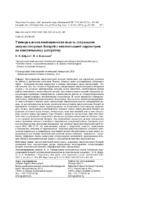| dc.contributor.author | Добрего, К. В. | |
| dc.contributor.author | Козначеев, И. А. | |
| dc.coverage.spatial | Минск | ru |
| dc.date.accessioned | 2022-12-07T13:01:13Z | |
| dc.date.available | 2022-12-07T13:01:13Z | |
| dc.date.issued | 2022 | |
| dc.identifier.citation | Добрего, К. В. Универсальная имитационная модель деградации аккумуляторных батарей с оптимизацией параметров по генетическому алгоритму = Universal Simulation Model of Battery Degradation with Optimization of Parameters by Genetic Algorithm / К. В. Добрего, И. А. Козначеев // Известия высших учебных заведений и энергетических объединений СНГ. Энергетика. – 2022. – № 6. – С. 481-498. | ru |
| dc.identifier.uri | https://rep.bntu.by/handle/data/123336 | |
| dc.description.abstract | Моделирование аккумуляторных батарей необходимо для управления режимом их работы и диагностики состояния. Важное значение имеет моделирование жизненного цикла – деградации базовых параметров в течение длительного срока эксплуатации. Это обусловлено тем, что стоимость буферизации электроэнергии аккумуляторными батареями связана с их ресурсом циклирования, который можно увеличить, оптимизировав режим работы накопителя в энергетической системе. Для существующих моделей деградации аккумуляторов характерны специфичность, ограниченность работы по стандартизированным циклам зарядки-разрядки, математическая громоздкость. В статье предложен универсальный подход, лишенный вышеуказанных недостатков. Используется концепция непрерывного износа батареи в течение срока эксплуатации. Представлена простая эмпирическая модель, не рассматривающая детально характеристики состояния аккумуляторных батарей на протяжении отдельного цикла зарядки-разрядки, не включающая вольтаические переменные. Модель рассматривает интенсивность текущего износа аккумуляторной батареи как функцию состояния заряда батареи, температуры, силы тока внешней цепи и тока саморазряда, полного заряда, протекшего через батарею с начала ее эксплуатации. При этом величина износа (деградации) определяется интегралом функции интенсивности текущего износа по времени эксплуатации батареи. Для оптимизации параметров модели используется метод случайного поиска в сочетании с генетическим алгоритмом отбора. Построена соответствующая модель деградации параметров для свинцово-кислотной аккумуляторной батареи Delta GEL-12-55, где использованы данные о деградации емкости, приведенные в техническом описании от производителя. Показаны работоспособность алгоритма оптимизации параметров и адекватность полученной модели. Разработанная модель может использоваться для технико-экономических расчетов систем генератор – накопитель – потребитель, гибридных систем накопления электроэнергии, компактного представления больших объемов экспериментальных данных о деградации конкретных аккумуляторов. Ключевые слова: электрохимический аккумулятор, деградация аккумуляторных батарей, жизненный цикл аккумуляторов, ресурс аккумулятора, моделирование аккумуляторных батарей, генетический алгоритм, непрерывный износ аккумулятора. | ru |
| dc.language.iso | ru | ru |
| dc.publisher | БНТУ | ru |
| dc.title | Универсальная имитационная модель деградации аккумуляторных батарей с оптимизацией параметров по генетическому алгоритму | ru |
| dc.title.alternative | Universal Simulation Model of Battery Degradation with Optimization of Parameters by Genetic Algorithm | |
| dc.type | Article | ru |
| dc.identifier.doi | 10.21122/1029-7448-2022-65-6-481-498 | |
| local.description.annotation | Modeling of batteries is necessary to control their operating mode and diagnose their condition. It is important to model the life cycle, i. e. degradation of basic parameters over a long service life. This is due to the fact that the cost of buffering electricity by batteries is associated with their cycling resource, which can be increased by optimizing the mode of operation of the drive in the energy system. The existing models of battery degradation are characterized by specificity, limited work on standardized charge-discharge cycles, and mathematical cumbersomeness. The article proposes a universal approach devoid of the above disadvantages. The concept of continuous battery wear during the service life is used. A simple empirical model is presented that does not consider in detail the characteristics of the state of batteries during a separate chargedischarge cycle, and does not include voltaic variables. The model considers the intensity of the current wear of the battery as a function of the state of its charge, temperature, the current of the external circuit and the current of self-discharge, the full charge that has flowed through the battery since the beginning of its operation. In this case, the amount of wear (degradation) is determined by the integral of the function of the intensity of current wear over the battery life. To optimize the parameters of the model, a random search method is used in combination with a genetic selection algorithm. The corresponding model of degradation of parameters for the Delta GEL-12-55 lead-acid battery has been constructed, in which the data on degradation of capacity given in the technical description from the manufacturer are used. The efficiency of the parameter optimization algorithm and the adequacy of the resulting model are shown. The model developed by the authors can be used for technical and economic calculations of generator – storage – consumer systems, hybrid power storage systems, and compact representation of large volumes of experimental data on the degradation of specific batteries. | ru |

